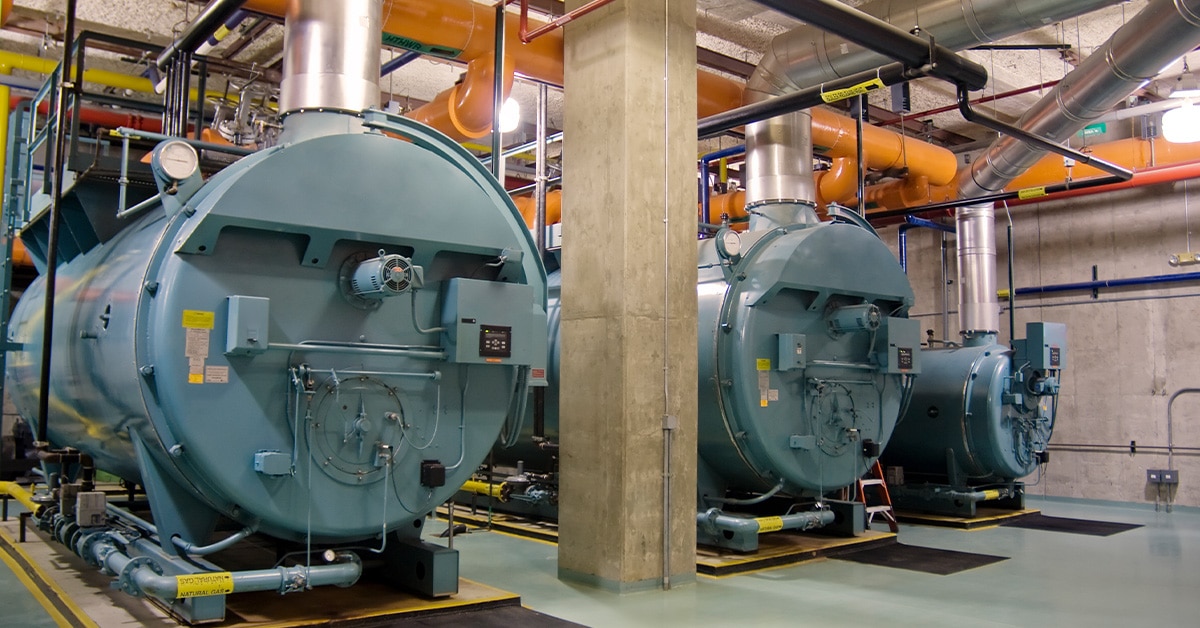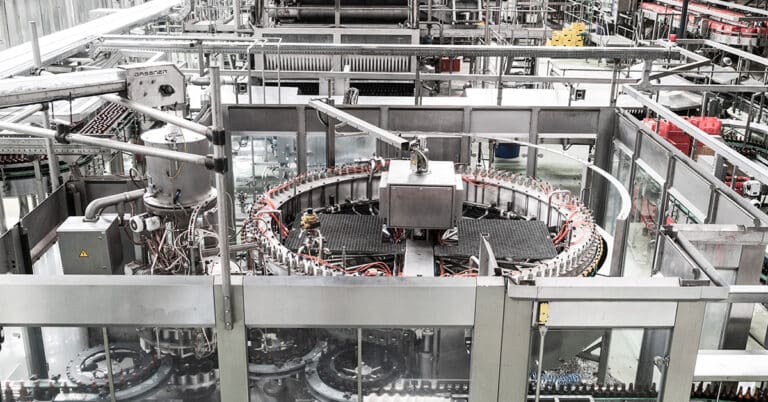Boilers generate steam, hot water and a long list of manufacturing processes. As pressure vessels, their maintenance and safety should always be a top priority, closely followed by ensuring they comply with applicable regulations, including those for emissions, and are operating efficiently.
Unplanned boiler downtime will disrupt production and has the potential to be very costly. To avoid this and to minimize the cost of producing steam and/or hot water, manufacturers must carry out regular industrial boiler maintenance.
This blog explains what’s needed and why. It also provides a checklist that can be taken as a guide to boiler preventive maintenance, though it should always be used in conjunction with the boiler manufacturer’s recommendations.
Key components of boiler maintenance
Industrial boilers burn natural gas or fuel oil (a few use other energy sources such as waste materials) and use the hot combustion gases to heat water. In the fire tube design, these gases pass through pipes surrounded by water, while the water tube design reverses this with the water being contained in pipes exposed to the combustion gases. Water tube boilers run at much higher pressures, which increases the importance of inspections and pressure relief valves.
The four key components of boiler maintenance are: water quality, the fuel system, pressure relief valves and the combustion chamber and flue. Here’s an overview of their functions.
Water quality
As water boils, the minerals it contains become sediment that settles at the bottom of pipes and tanks. Depending on acidity or alkalinity, water can also cause scale along pipe walls. Sediment and scale reduce boiler efficiency and can shorten its life. They are reduced by monitoring water quality and treating it with chemicals as needed.
Fuel system inspection
The condition of fuel lines, burners and control systems should be checked regularly to ensure efficient combustion. Note that with dual fuel boilers there is twice as much to inspect!
Pressure relief valves
These essential safety devices must be tested regularly to ensure they operate correctly and pressure is not allowed to rise to hazardous levels. Closely related is the water gauge glass. This provides a visual indication of whether the boiler has enough water. It should be checked frequently and replaced if it becomes too stained for the water level to be seen.
Combustion chamber and flue
These should be cleaned and inspected regularly to guard against the buildup of soot. Stack temperatures should be monitored, and combustion gases analyzed to ensure the system is operating at peak efficiency.
Why industrial boiler maintenance is essential
Steam, hot water and the boilers that produce them are often thought of as “utilities” and not prioritized for maintenance. This can be an expensive, and even dangerous, omission. Boiler system maintenance is important for:
- Safety: Regular inspections help prevent dangerous boiler malfunctions, which can include explosions.
- Regulatory compliance: In most states, boilers are subject to annual inspection for integrity and safety. In addition, efficient combustion minimizes flue gases, which are also regulated.
- Efficiency: Well-maintained boilers maximize the efficiency with which energy is turned into heat and reduce emissions.
- Cost savings: Preventive maintenance minimizes unplanned downtime of both the boiler itself and the processes for which it supplies steam. It reduces the frequency and cost of making repairs and extends boiler lifespan.
Machine health monitoring for industrial boilers
Preventive maintenance (PM), which involves making inspections and performing servicing on a scheduled basis, reduces unplanned downtime but requires the boiler be taken out of service periodically. While this is often scheduled for weekends and annual shutdowns, it can still result in lost production. There’s also the possibility of doing PM more frequently than is needed or doing the wrong PM, which doesn’t prevent unplanned downtime.
The answer to these is to implement machine health monitoring technology. This refers to instrumenting the boiler and related equipment — such as the fuel system, — with sensors that provide information on status and condition. This can include water level sensors, industrial pressure sensors and flow meters, along with industrial temperature sensors and thermal imaging, gas analyzers and sensors for fan/blower motor current draw. It’s even possible to perform corrosion monitoring, using ultrasonic sensors that measure and report tube thickness.
When these sensors monitor conditions continuously, they can report anomalous events or send data in real time to a remote computer for analysis and storage. By detecting fluctuations in boiler conditions, they allow immediate action to prevent problems, avoiding breakdowns and improving efficiency.
Condition monitoring can also form the basis of a predictive boiler maintenance plan. Predictive maintenance, (PdM) is a strategy where trends are monitored and used to predict failure. This enables scheduling of PM to prevent breakdowns while helping optimize maintenance schedules and reduce unplanned downtime.
Common industrial boiler problems and how to address them
The most common problems with industrial boilers are low steam pressure or no steam, water cooler than expected/required and reduced efficiency. These usually result from faults with the water system, defective valves and failure of the pilot or burner ignition.
Water system problems
Water with high levels of minerals produces sediment as it turns to steam. Anything other than a neutral pH will accelerate corrosion of tubes, manifolds and other piping system components. This causes scale that settles at the bottom of tanks and tubes and reduces heat transfer efficiency.
Low water level can trigger an automatic boiler shutdown to prevent an explosion. This sensor should be checked regularly. Water-related problems are prevented by ensuring the treatment system is operating reliably. In addition, the low water cutout should be checked frequently, and the gauge glass kept clean.
Boiler blowdowns are a way of flushing out debris to keep the boiler working efficiently. These should be done on a schedule or when sensors indicate it would be beneficial.
Defective valves
Valves, used in both water and fuel systems, can weep or leak from glands and/or packing, and from defective gaskets. They may also stick, especially if operated infrequently, which is a particular problem for pressure relief valves. Faulty operation can often be detected by sensors installed in both the actuators and the pipes. Small leaks will only be found through visual inspection. Pressure relief valves must be tested to detect sticking.
Ignition failure
Many factors can prevent ignition, from electrical faults and damaged insulation to problems with the fuel supply or fuel quality. Soot buildup on thermocouples can be a problem, giving the controller incorrect temperature values.
A common related issue is blocked or fouled orifices in the burner. This again can result from soot buildup. It results in inefficient combustion and can increase emissions from the stack.
The main way of addressing ignition problems is to vacuum out dust and soot and check the integrity and operation of sensors, valves and pipes. Components with ceramic insulators are susceptible to cracking and should be replaced whenever problems are experienced.
Boiler maintenance checklist
When putting together a boiler maintenance plan, it’s important to follow the manufacturer’s recommendations. In general, this will cover daily, weekly, monthly/quarterly and annual checks, usually covering the points listed in the following generic checklist:
Daily
- Check water level in the gauge glass
- Check the boiler control system display panel for any error codes or messages
- Check on the quantities of consumables in the water treatment system
- Verify temperature and pressure readings are within the expected range
- Perform a boiler blowdown
Weekly
- Observe flame color through the boiler’s sight port
- Check for soot buildup
- Check condition of pipes and ducting
- Check operation of low water cutout
- Test water quality/condition
- Review system logs for irregularities
Monthly
- Test pressure relief valves
- Examine the burner’s diffuser for burning, cracking or deforming
- Check the burner’s pilot tube for pilot ignition
- Check burner valves for wear, slip and/or proper action
- Monitor fuel supply lines
- Check for hotspots on the boiler’s exterior (a good application for thermal imaging equipment)
Annual
- Conduct a full system inspection, including cleaning, testing controls and recalibrating sensors
- Check for heavy scaling on tubes, tubesheets and shell
- Have external pressure and emission checks performed as required to maintain regulatory compliance
Expert support for care of key assets
Steam and hot water are often taken for granted until they’re not available in the right quantities. When that happens, attention turns to the boiler, which may need emergency breakdown maintenance. While that work is done, equipment and processes are often idled because production can’t continue.
Even if a neglected boiler continues to function, it won’t be running at peak efficiency. That’s expensive because it will use far more energy than it should, and it may also result in emissions from the furnace stack exceeding allowable limits. In the worst-case scenario, an improperly maintained boiler can explode as pressure builds up inside.
ATS helps manufacturers keep key assets like boilers in top operating condition. Our services range from short-term help in dealing with spikes in maintenance workload to long-term services and a suite of predictive maintenance solutions. Contact us for more information.






